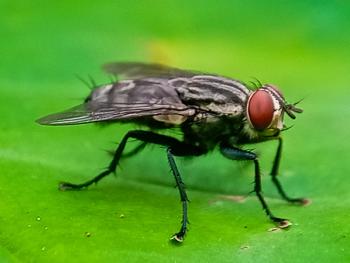
Toxocara cati (Proceedings)
Despite the advent of highly effective, easily administered broad-spectrum parasite control products for cats, infection with intestinal parasites in general, and ascarids (roundworms) in particular, remains a common finding in cats.
Despite the advent of highly effective, easily administered broad-spectrum parasite control products for cats, infection with intestinal parasites in general, and ascarids (roundworms) in particular, remains a common finding in cats. Toxocara cati is of particular concern because it not only induces disease in cats, but also poses a risk of infection to people. Wellness programs should include measures to actively seek to identify feline intestinal parasites through routine fecal examination performed under best practice guidelines, as well as proactively manage both cats to limit infections with ascarids and other common intestinal parasites. This presentation will review the importance of Toxocara cati as a pathogen of cats and a potential zoonosis, provide current prevalence data for pet cats in the United States, and suggest strategies to limit infections with Toxocara cati.
Toxocara cati is the most commonly identified intestinal parasite in cats
Cats in North America may be infected with ascarids (Toxocara cati, Toxascaris leonina), hookworms (Ancylstoma tubaeforme, A. braziliense, or rarely Uncinaria stenocephala), and Giardia spp. Of these, ascarid infection, particularly infection with T. cati, is by far the most common. Cats acquire ascarids by ingestion of larvated eggs or ingestion of larvae in the muscle tissues of transport hosts; with continued exposure the risk of infection and re-infection remains high throughout the life of a cat. Transplacental transmission of T. cati is not known to occur, but kittens may infected from the dam transmammarily.
The most common and important zoonotic intestinal parasites of cats that fecal flotation is effective for diagnosing are listed in Table 1. Infection rates with each of these parasites vary according to age, lifestyle, and other factors that impact exposure and susceptibility rates of individual cats. Data on infections in cats are somewhat limited compared to that in dogs, and both clients and some veterinarians may have the erroneous impression that parasitism is relatively uncommon in pet cats. However, more recently acquired national data is demonstrating that infections with these parasites commonly occur in pet cats, with almost 10% of pet cats shown to be shedding eggs of at least one parasite on single fecal examination. A recent study of fecal examination results from samples submitted from over 250,000 pet cats across the United States showed that ascarid infection is very common in cats, with 5.5% of pet cats shedding T. cati nationally; in some areas, such as the Midwestern US, infection rates are as high as 10.6% (Johnson and Little, unpublished data). Appropriate fecal examination techniques (i.e. active centrifugation with an adequate sample size) must be used to identify these infections; when centrifugation is not performed, many infections are missed.
Table 1. Common and important intestinal parasites of cats in the United States.
Toxocara cati as a zoonotic agent
Like Toxocara canis from dogs, Toxocara cati is a zoonotic pathogen capable of inducing visceral and ocular larva migrans as well as other forms of toxocariasis in people. People, usually children, become infected with T. cati when they ingest larvated, infective eggs from an environment previously contaminated with feces from an infected cat. A recent survey revealed 13.9% of people in the US are seropositive to Toxocara spp.; seroprevalence was higher in rural communities and in those of lower socioeconomic status (Won et al., 2008). Indeed, toxocariasis is now considered a disease of poverty in the US (Hotez, 2009). Toxocara cati contributes to the disease burden in people, in part, because cats remain highly susceptible to infection with T. cati throughout their life. Cats of all ages may harbor ascarids and cats are also much less likely that dogs to be maintained on a monthly heartworm preventive product with efficacy against ascarids, and thus infections are more likely to persist long-term. Because many pet cats have access to a litter box in the home, the risk of zoonotic infection exists indoors as well as in the area around the home where cats defecate.
Strategies to limit infection with Toxocara cati
Controlling ascarids in cats, like controlling all parasites, requires awareness of the risk of infection, routine diagnostic protocols, and diligent attention to administering control products as recommended. The Companion Animal Parasite Council recommends that a fecal examination by centrifugal flotation be performed on every pet one to two times a year. In addition, routine administration of year-round broad spectrum parasite control products with efficacy against heartworm, intestinal parasites, and fleas can greatly limit infections in cats, reducing the likelihood of either cats or people developing parasite-related disease.
The current Companion Animal Parasite Council guidelines (
1. Parasite control should be guided by veterinarians.
- This recommendation encourages veterinarians to prescribe control programs to local parasite prevalence and individual pet lifestyle factors and to adapt and modify protocols as new information about the threat of parasitism emerges. Integrating comprehensive parasite control strategies, including routine centrifugal fecal flotation, into the regular wellness examination can greatly enhance the effectiveness of parasite control.
2. Every pet, all year long.
- To protect pet health and human health, the CAPC continues to endorse the use of year-round broad spectrum parasite control in both dogs and cats, focusing on prevention of heartworm and control of intestinal parasites, fleas, and ticks. Particular attention is due puppies and kittens, which benefit from both early deworming and routine broad spectrum control as soon as the label allows.
3. Healthy lifestyle, healthy pets, healthy people.
- A number of basic management decisions can limit the exposure of both pets and people to parasites of dogs and cats, augmenting the use of routine control products and further reducing risk of infection. Some common strategies include feeding pets only cooked or prepared food, covering sandboxes when not in use, immediate or routine removal of feces from the environment, preventing roaming in dogs and keeping cats indoors, and practicing basic good hygiene (e.g. washing hands).
4. If less than optimal control is practiced:
- The CAPC recognizes that, despite the best efforts of the veterinary profession, at present approximately half of dogs and a minority of cats receive year-round broad spectrum parasite control. Additional recommendations have been developed for those cases when less than optimal control is practiced and include routine deworming, again focused on puppies and kittens, every 2 weeks of age until 2 months old, then monthly until the pet is 6 months old. At that point, if routine control is still not accepted, a risk assessment should be performed. For patients at high risk of infection (e.g. cats allowed to hunt, dogs with access to areas frequented by other dogs), routine deworming two to four times a year together with fecal examination, when possible, is recommended.
Table 2. Treatment and control of ascarids and other intestinal parasites of cats
Selected references (additional detailed references available upon request)
Carlin EP, Bowman DD, Scarlett JM, et al., 2006. Prevalence of Giardia in symptomatic dogs and cats throughout the United States as determined by the IDEXX SNAP Giardia test. Vet Ther 7(3):199-206.
Companion Animal Parasite Council Guidelines, Ascarids.
Bowman DD, 1999. Georgis' Parasitology for Veterinarians. (7th ed) Philadelphia:WB Saunders Co., p186
Newsletter
From exam room tips to practice management insights, get trusted veterinary news delivered straight to your inbox—subscribe to dvm360.




